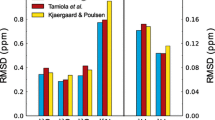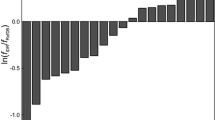Abstract
A list of proteins is given for which spatial structures, with a resolution better than 2.5 Å, are known from entries in the Protein Data Bank (PDB) and isotropic chemical shift (ICS) values are known from the RefDB database related to the Biological Magnetic Resonance Bank (BMRB) database. The structures chosen provide, with unknown uncertainties, dihedral angles φ and ψ characterizing the backbone structure of the residues. The joint use of experimental ICSs of the same residues within the proteins, again with mostly unknown uncertainties, and ab initio ICS(φ,ψ) surfaces obtained for the model peptides For–(l-Ala) n –NH2, with n = 1, 3, and 5, resulted in so-called empirical ICS(φ,ψ) surfaces for all major nuclei of the 20 naturally occurring α-amino acids. Out of the many empirical surfaces determined, it is the \(^{13}\hbox{C}^{\alpha}\) ICS(φ,ψ) surface which seems to be most promising for identifying major secondary structure types, α-helix, β-strand, left-handed helix (αD), and polyproline-II. Detailed tests suggest that Ala is a good model for many naturally occurring α-amino acids. Two-dimensional empirical \(^{13}\hbox{C}^{\alpha}\) –\(^{1}\hbox{H}^{\alpha}\) ICS(φ,ψ) correlation plots, obtained so far only from computations on small peptide models, suggest the utility of the experimental information contained therein and thus they should provide useful constraints for structure determinations of proteins.










Similar content being viewed by others
References
Becke AD (1988) Density-functional exchange-energy approximation with correct asymptotic-behavior. Phys Rev A 38:3098
Beger RD, Bolton PH (1997) Protein phi and psi dihedral restraints determined from multidimensional hypersurface correlations of backbone chemical shifts and their use in the determination of protein tertiary structures. J Biomol NMR 10:129–142
Bernstein FC, Koetzle TF, Williams GJB, Meyer EF, Brice MD, Rodgers JR, Kennard O, Shimanouchi T, Tasumi M (1977) Protein data bank – computer-based archival file for macromolecular structures. J Mol Biol 112:535–542
Braun D, Wider G, Wuthrich K (1994) Sequence-corrected N-15 random coil chemical-shifts. J Am Chem Soc 116:8466–8469
Czinki E, Császár AG, Perczel A (2003) A theoretical case study of type I and type II beta-turns. Chem-Eur J 9:1182–1191
Czinki E, Császár AG (2004) On NMR isotropic chemical shift surfaces of peptide models. J Mol Struct (THEOCHEM) 675:107–116
Czinki E, Császár AG, Magyarfalvi G, Schreiner PR, Allen WD (2007) Secondary structures of peptides and proteins via NMR chemical-shielding anisotrophy (CSA) parameters. J Am Chem Soc 129:1568–1577
Dalgarno DC, Levine BA, Williams RJP (1983) Structural information from NMR secondary chemical-shifts of peptide Alpha-C-H protons in proteins. Biosci Rep 3:443–452
Ditchfield R (1974) Self-consistent perturbation theory of diamagnetism. Mol Phys 27:789–807
Frisch MJ et al (1998) Gaussian98, A11, Gaussian Inc., Pittsburgh, PA
Frisch MJ et al (2004) Gaussian03, Rev C02, Gaussian Inc., Wallingford, CT
Gronenborn AM, Clore GM (1994) Identification of N-terminal helix capping boxes by means of C-13 chemical shifts. J Biomol NMR 4:455–458
Helgaker T, Jaszunski M, Ruud K (1999) Ab initio methods for the calculation of NMR shielding and indirect spin-spin coupling constants. Chem Rev 99:293–352
Ho BK, Thomas A, Brasseur R (2003) Revisiting the Ramachandran plot: Hard-sphere repulsion, electrostatics, and H-bonding in the alpha-helix. Protein Sci 12:2508–2522
Hovmoller S, Zhou T, Ohlson T (2002) Conformations of amino acids in proteins. Acta Crystallogr Sect D – Biol Crystallogr 58:768–776
Iwadate M, Asakura T, Williamson MP (1999) C-alpha and C-beta carbon-13 chemical shifts in proteins from an empirical database. J Biomol NMR 13:199–211
Kleywegt GJ, Jones TA (1996) Phi/psi-chology: Ramachandran revisited. Structure 4:1395–1400
Le HB, Pearson JG, de Dios AC, Oldfield E (1995) Protein-structure refinement and prediction via NMR chemical shifts and quantum-chemistry. J Am Chem Soc 117:3800–3807
Lee C, Yang W, Parr RG (1988) Development of the colle-salvetti correlation – Energy formula into a functional of the electron-density. Phys Rev B 37:785
Neuhaus D, Williamson M (1989) The nuclear overhauser effect in structural and conformational analysis. VCH, New York
Ősapay K, Case DA (1991) A new analysis of proton chemical-shifts in proteins. J Am Chem Soc 113:9436–9444
Ősapay K, Case DA (1994) Analysis of proton chemical-shifts in regular secondary structures of proteins. J Biomol NMR 4:215–230
Perczel A, Császár AG (2000) Toward direct determination of conformations of protein building units form multidimensional NMR experiments part I: A theoretical case study of For-Gly-NH2 and For-L-Ala-NH2. J Comp Chem 21:882–900
Perczel A, Császár AG (2001) Toward direct determination of conformations of protein building units form multidimensional NMR experiments part II: A theoretical case study of Formyl-L-Valine amide. Chem Eur J 7:1069–1083
Perczel A, Császár AG (2002) Toward direct determination of conformations of protein building units form multidimensional NMR experiments part III: A theoretical case study of For-L-Phe-NH2. Eur Phys J D 20:513–530
Perczel A, Füzéry AK, Császár AG (2003) Toward direct determination of conformations of protein building units form multidimensional NMR experiments part V: NMR chemical shielding analysis of N-formyl-serinamide, a model for polar side-chain containing peptides. J Comp Chem 24:1157–1171
Ramachandran G, Sasikekharan V (1968) Conformation of polypeptides and proteins. Adv Protein Chem 23:283–437
Redfield C, Dobson CM (1990) H-1-NMR studies of human lysozyme – Spectral assignment and comparison with hen lysozyme. Biochemistry 29:7201–7214
Schafer A, Huber C, Ahlrichs R (1994) Fully optimized contracted gaussian-basis sets of triple zeta valence quality for atoms Li to Kr. J Chem Phys 100:5829–5835
Seavey BR, Farr EA, Westler WM, Markley JL (1991) A relational database for sequence specific protein NMR data. J Biomol NMR 1:217
Spera S, Bax A (1991) Empirical correlation between protein backbone conformation and C-alpha and C-beta C-13 nuclear-magnetic resonance chemical shifts. J Am Chem Soc 113:5490–5492
Szilágyi L (1995) Chemical-shifts in proteins come of age. Progr Nucl Magn Res Spectr 27:325–443
Szilágyi L, Jardetzky O (1989) Alpha-proton chemical-shifts and secondary structure in proteins. J Magn Reson 83:441–449
Sun HH, Sanders LK, Oldfield E (2002) Carbon-13 NMR shielding in the twenty common amino acids: Comparisons with experimental results in proteins. J Am Chem Soc 124:5486–5495
Vlasov PK, Kilosanidze GT, Ukrainskii DL, Kuzmin AV, Tumanyan VG, Esipova NG (2001) Left-handed conformation of poly-L-proline II type in globular proteins. Sequence specificity. Biofizika 46:573–576
Wang YJ (2004) Secondary structural effects on protein NMR chemical shifts. J Biomol NMR 30:233–244
Wishart DS, Sykes BD, Richards FM (1991) Relationship between nuclear-magnetic resonance chemical-shift and protein secondary structure. J Mol Biol 222:311–333
Wishart DS, Sykes BD, Richards FM (1992) The chemical-shift index – A fast and simple method for the assignment of protein secondary structure through NMR-spectroscopy. Biochemistry 31:1647–1651
Wishart DS, Case DA (2001) Use of chemical shifts in macromolecular structure determination. Meth Enzymol 338:3–34
Wolinski K, Hinton JF, Pulay P (1990) Efficient implementation of the gauge-independent atomic orbital method for NMR chemical-shift calculations. J Am Chem Soc 112:8251–8260
Xu XP, Case DA (2001) Automated prediction of N-15, C-13(alpha), C-13(beta) and C-13’ chemical shifts in proteins using a density functional database. J Biomol NMR 21:321–333
Xu XP, Case DA (2002) Probing multiple effects on N-15, C-13 alpha, C-13 beta and C-13’ chemical shifts in peptides using density functional theory. Biopolymers 65:408–423
Yao J, Dyson HJ, Wright PE (1997) Chemical shift dispersion and secondary structure prediction in unfolded and partly folded proteins. FEBS Lett 419:285–289
Zhang HY, Neal S, Wishart DS (2003) RefDB: A database of uniformly referenced protein chemical shifts. J Biomol NMR 25:173–195
Acknowledgments
The work described has been supported by the Scientific Research Fund of Hungary (Grant No. OTKA T047185).
Author information
Authors and Affiliations
Corresponding author
Electronic supplementary material
Below is the link to the electronic supplementary material.
Rights and permissions
About this article
Cite this article
Czinki, E., Császár, A.G. Empirical isotropic chemical shift surfaces. J Biomol NMR 38, 269–287 (2007). https://doi.org/10.1007/s10858-007-9161-y
Received:
Accepted:
Published:
Issue Date:
DOI: https://doi.org/10.1007/s10858-007-9161-y




